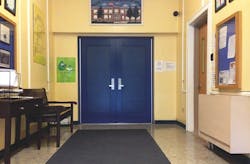What the states should do to prevent more school shootings
(Editor's Note: This blog post is part of BD+C's five-part special report on security design for K-12 school projects. Read the full report.)
To tell the truth, I didn’t want to write about the terrible events of December 14, 2012, when 20 children and six adults were gunned down at Sandy Hook Elementary School in Newtown, Conn. I figured other media would provide ample coverage, and anything we did would look cheap or inappropriate.
Two things turned me around. The first was hearing from AEC professionals and manufacturers of door hardware, blastproof glass, and other security products, who said they couldn’t keep up with the phone calls from school officials across the country, all of them desperate for a quick fix so that “another Sandy Hook” would never happen on their watch. Irene Nigaglioni, a Partner at PBK Architects, told me that one school official even asked her about bulletproof furniture.
The thing that really got me, though, was that the shootings just kept going on and on. By the first anniversary of the Sandy Hook incident, more than 20 school shootings had taken place in the U.S., including one in Sparks, Nev., where a teacher was killed, and another just this past December 13, in Centennial, Colo., barely 10 miles from the infamous Columbine High School.
Meanwhile, in Newtown, 88% of the 5,062 voters overwhelmingly approved a referendum to tear town the mid-1950s elementary school and build a new one on the same site, with funding coming from a $50 million grant from the state. Svigals + Partners won the design competition, with Consigli Construction as project manager.
When the vote was reported on Yahoo (http://yhoo.it/JZ9R5I), more than 2,000 people responded, many of them angry at what they saw as the waste of a good building, others outraged by the opulence of the grant.
“50 million dollars?” wrote one. “That school must have solid-gold toilets, valet parking, limousine service for every child, five-star French chefs, and platinum silverware for the kids to eat with!”
Meanwhile, Governor Dannel P. Malloy’s Sandy Hook Advisory Commission issued an interim report last March (the final report is expected later this year), based in part on input from informational meetings on infrastructure design, school safety and security, and gun violence.
The Commission made only two specific recommendations: 1) that all K-12 classrooms be equipped with doors that could be locked from the inside by the teacher, and 2) that all exterior doors be equipped with hardware capable of implementing a full perimeter lockdown.
In addition, the Commission recommended that school districts “consider” developing an All-Hazards Threat and Risk Assessment Security Recommendations (TRASR) tool on a site-specific basis, to include “rational and credible protective design of building and site components” based on Crime Prevention Through Environmental Design (CPTED) strategies.
The report noted that “no standard exists for the baseline of safe school design or a process to determine appropriate safe school design elements.” In fact, most states have no standards or regulations on security in the design of schools.
We think it’s time for the states, working through such groups as the National Conference of State Legislatures and the National Governors Association, to put “security” into their requirements for school construction. As we note in our Special Report, however, security design and technology can only go so far. Training and preparedness at the local level are equally important.
(Editor's Note: This blog post is part of BD+C's five-part special report on security design for K-12 school projects. Read the full report.)
About the Author

Rob Cassidy
Robert Cassidy is Executive Editor of Building Design+Construction and the Editor of Multifamily Design+Construction. A city planner, he is the author of several books, including “Livable Cities,” and was a co-founder of the Friends of the Chicago River.
